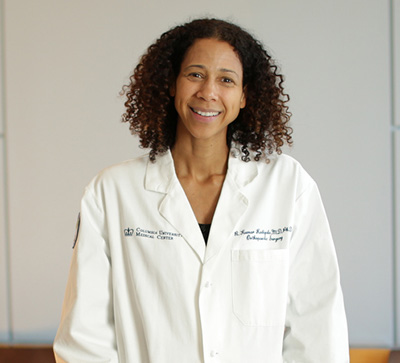Orthopedic Oncology
The Orthopedic Oncology Service, under the direction of Wakenda K. Tyler, MD, MPH, offers expertise in the treatment of benign and malignant tumors in patients of all ages. As a musculoskeletal oncologist, Dr. Tyler specializes in the diagnosis and management of primary soft tissue and bone cancers, sarcomas, and metastatic bone cancer with particular expertise in nonoperative therapies and minimally invasive and reconstructive surgical techniques. When cure is not possible, she strives to achieve pain control and improve optimal function.

Dr. Wakenda K. Tyler
The strength of the Orthopedic Oncology Service lies in a multidisciplinary approach for the care of each patient in which orthopedic surgeons collaborate closely with medical oncologists and radiation oncologists to offer a range of treatment options and approaches. Together, they employ precision medicine to identify the most efficacious therapies for each tumor type.
Targeted Therapies
Through a project spearheaded by Gary K. Schwartz, MD, Chief of Hematology/Oncology and Interim Director of the Herbert Irving Comprehensive Cancer Center at Columbia, every sarcoma biopsy is genetically sequenced, a service not yet available in most hospitals. The results inform the personalized treatment protocol that Dr. Tyler recommends to hone in on particular genetic features of the tumor. Genetic testing on all malignant tumors and some benign tumors to identify the genetic abnormality allows Dr. Tyler to target the tumor with newer therapeutic agents in development. The targeted therapies aim to increase 10-year survival from 50 percent to 60 or 70 percent.
Preparing for Rehabilitation
With nearly every sarcoma patient undergoing surgery, which can radically alter mobility and function, Dr. Tyler connects patients with specialists in rehabilitation medicine prior to their surgery. For many people, the pain and impeded movement caused by a tumor forces them to compensate, favoring one leg over the other, for example. As a result, many have functional deficits or mobility impairments even before the tumor is removed, making physical and occupational therapy vital contributions to ongoing quality of life. In this way, patients postoperatively will already have a network of physicians and staff who are aware of the functional issues and ready to support them.
Intra-Articular Tumors
In a study published in the December 2018 issue of The Journal of Bone & Joint Surgery, Dr. Tyler and her colleagues focused on the challenges of diagnosing intra-articular tumors, which are often mistaken for other non-neoplastic conditions, and the importance of recognizing when surgical or nonsurgical treatment is indicated. The authors recommend that with these tumors, physicians look for more subtle signs of a malignant or more aggressive benign process, including employing contrast magnetic resonance imaging, and if detected, refer patients to an orthopedic oncologist for evaluation and management.
Genetic testing is performed on all malignant tumors and some benign tumors to identify the genetic abnormality that will allow our physicians to target the tumor with newer therapeutic agents in development.



